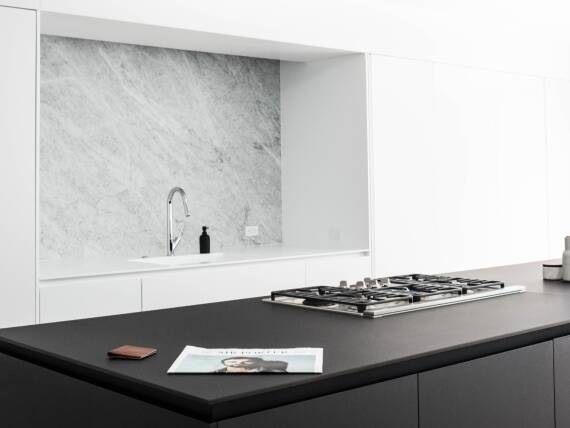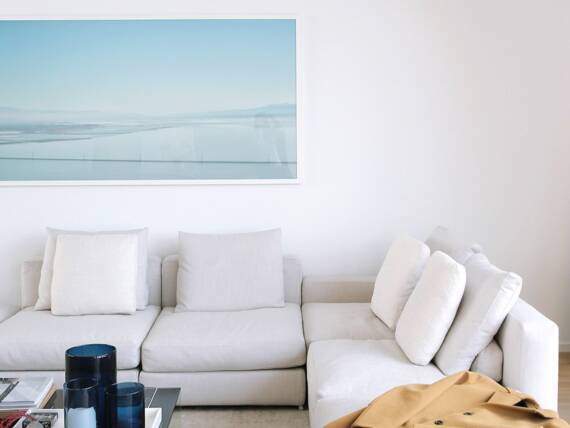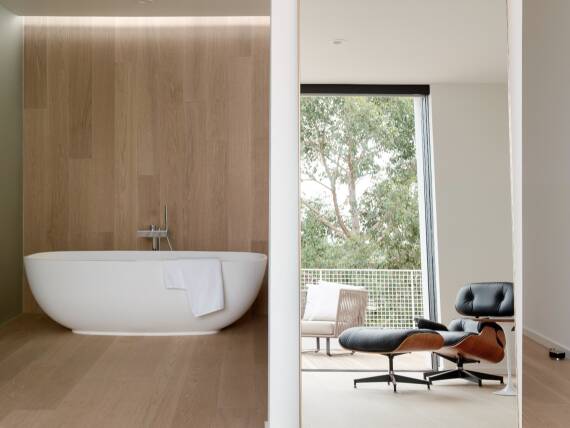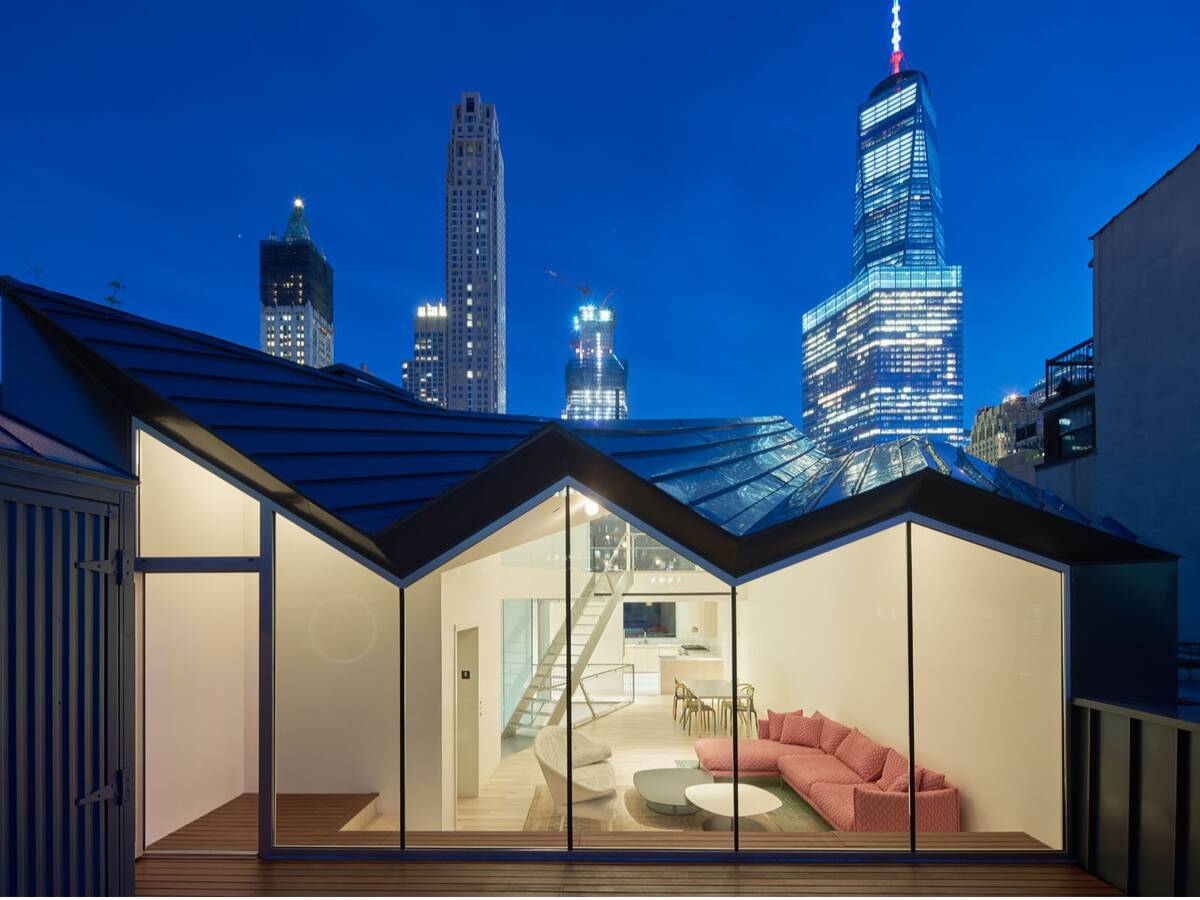
The AXOR interview
Robert Edmonds and Vivian Lee: Switchback House
Edmonds + Lee Architects have earned international recognition for their contemporary approach to homes and housing. Partners in work and life, Robert Edmonds and Vivian Lee exemplify that approach in the Switchback House, which they designed for themselves and their two children. The architects speak with AXOR about their San Francisco home and the Compact Luxury principles embodied in its design.

Density and connection
AXOR: From your point of view as architects, what is the future of urban living?
Vivian Lee: We are in the middle of the COVID crisis, and in some ironic way, it reminds people of how much they love association with other human beings, how much they miss it. I think this exodus, at least in the US right now, to [rural settings] is very much a temporary reaction. After COVID, I think architects and urban planners are going to be asking, How do you make density better than before? At the end of the day, we’re very social animals.
Robert Edmonds: And specifically on the future of urban living, new trends we’re seeing are things like cities densifying, and especially in a city like San Francisco, which is relatively low-density by global standards, we’re finding all kinds of ways to do creative housing, increase affordability for people and make cities better, nicer places to live. Whether that’s through accessory dwelling units or a pedestrian-scale removal of the cars from the city, these are also ecological responses.Prioritising health and well-being
AXOR: And what have you learned from your urban clients about their evolving needs?
RE: I think COVID has really accelerated trends we were already seeing, trends that have to do with wellness. We had a client who used to think that health is the ultimate luxury. So, for example, you have more emphasis on proper spaces for exercise, rooms with access to light, rooms with access to the outdoors.
VL: And airtight homes where fresh air is filtered. We were already doing that a few years ago on these ultra-luxury houses. Now, I think we will see more and more developers putting these systems into place to promote healthy buildings.
Urban luxury
AXOR: What does luxury mean in the urban context, now and going forward?
VL: Robert mentioned health as the ultimate luxury, and I think that couldn’t be more true in today’s context. Homes need to be functional, but they also need to act as a sanctuary, whether they’re 400 square feet or 4,000 square feet.
RE: And there are two types of health, physical but also mental. We really believe in the power of architecture to address both of these.

Optimising space and enhancing it
AXOR: What can architects do not just to optimise space in urban homes but to enhance it—to give it meaning, character, soul?
RE: Well, that’s the ultimate job of the architect, right? It’s the essential problem we’re trying to solve. In terms of optimisation, there are market forces that may dictate how buildings are built or how spaces are allocated. In the case of the Switchback House, we could have built a much bigger house, but we wanted spaces that had kind of a richness and quality to them. That meant giving up some things to make it an optimal house architecturally. So, for example, our home has only three bedrooms. We could have fit four, but we wanted nicer spaces.A non-traditional plan
AXOR: What particular challenges did the Switchback House project present, and how did you solve them?
VL: San Francisco, like New York and London, has very restricted lot sizes. And there is an obsession with capturing the view or not having anyone block it. The fight over views is a million dollar business here for lawyers. So we knew we were going to encounter some of it, but instead of being aggressive with our design, we thought of a very logical way to combat these problems – we did a ‘flip’ house. We feel that, nowadays, there’s no need to adhere to the traditional notions, so instead of coming into the traditional home, we completely flip the plan. And doing that, our view, which is in the living room, where we are most of the time, is at the highest elevation. We don’t have to get upset with our neighbors, and they don’t have to get upset with us. And because we flipped the floor plan, when you wake up in the morning, you walk upstairs to get your coffee or tea, and that ritual of ascending the stair toward the light is very uplifting.
RE: We practice modern and contemporary architecture. Having the privilege and opportunity to build something new in San Francisco doesn’t come along often, so it was really important to us to do something that fit into the neighborhood but was still of our time. There are certain kinds of precedent typologies that you might find in Victorian houses. So, for example, we have a Front stoop. We have a slope roof to fit the neighborhood, so there are textured views from other houses. But as Vivian said, we really had to optimise the interior, and that had to do with eliminating redundant spaces. You really feel the space in the house, and this maximises the enjoyment.
Creating a ‘domestic spa’
AXOR: How does the Switchback House reflect Compact Luxury principles?
RE: The thing about our home is that it’s very open. The spaces flow, and that allows a kind of compact architecture to feel much more expansive. And we have access to the outdoors, which, in American cities, seems like a bit of a luxury. At every level of our home, there’s an outdoor deck with big, long doors that you can open when the weather’s nice.
VL: And I think the idea of the ‘domestic spa’ was important. If you view your home as a sanctuary, every opportunity should be taken to emphasise those values. So with a modest budget, how can you push the idea of luxury in a way that is unique? We didn’t need to put Italian marble into a bathroom to make it feel luxurious. We continued the wooden floor into the dry area of the bathroom, which is something the US market is very averse to. When the bathroom doors are open, it’s a continuation of the bedroom experience, using the same material. And I have no problem looking at my beautiful sink with the AXOR taps when I wake up in the morning. It’s one continuous visual experience.
RE: Every bathroom has a slightly different character, but there are some common threads. For example, AXOR taps in all the bathrooms.

Wellness in the bathroom
AXOR: How did your choice of AXOR contribute to the overall experience what you were trying to create?
RE: Using AXOR products reflected our qualitative values, which I mentioned earlier. Plumbing, fixtures and taps – these are things we interact with daily, all the time. They’re something that we touch, feel. You know, it affects our wellness. It affects our health. And these qualitative things were really important to us. So, for example, we’ve always been attracted to the AXOR Uno tap. It is just so clean and pure. It’s a perfect reflection of just a tap – nothing less, nothing more. It’s just a perfect thing. But in terms of the idea of luxury and things that go beyond that, whether we call it flow or embellishment or whatever, we were interested in other AXOR lines as well. Throughout the home, we’ve used AXOR Urquiola towel bars, which have a little bit more personality beyond the strictly minimalist aspect. So within the home, you’ll see AXOR Uno, some AXOR Urquiola, some AXOR Starck, but they all go together cohesively.
VL: If I had another tub, I would use AXOR Massaud – that beautiful waterfall.
Personal ideas of luxury
AXOR: What is luxury for you?
VL: On the work Front, it’s the freedom to design, to try out new ideas. As I always say to our developer clients especially, it’s not the challenging budget that frightens me. But you have to allow me the freedom to design around that budget.
RE: And luxury for me has to do with health and the qualitative aspects to living. If I had to characterise it in a series of words, I would say freedom, flexibility, openness. I think these are luxuries we too often take for granted. But as we realised over the course of this past year, What are the important things in life? And I’m constantly reminding myself that most of the world does not live in architect-designed homes, and being able to do what we do and make spaces for people to live in, which is really the most intimate type of space, that in and of itself is a luxury.
Trusted partners


